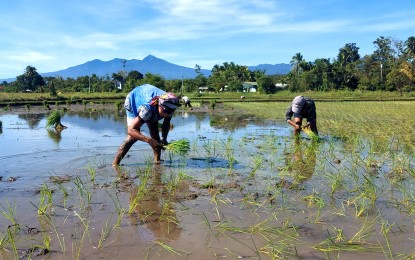
(PNA file photo)
MANILA – The Department of Agriculture (DA) said Saturday there are no plans to recommend a price ceiling or suggested retail price (SRP) on rice amid its inflation uptick of 24.4 percent in March.
“Wala kaming plano na magkaroon ng price cap or SRP kasi medyo may mga mabigat din na epekto iyan pagdating ng panahon (We don't plan to have a price cap or SRP because it could have a huge impact in the future),” Department of Agriculture Assistant Secretary Arnel De Mesa said at the Saturday News Forum in Quezon City.
The rice inflation in March eclipsed February's 23.7 percent and is the highest since 2009.
De Mesa explained that the increase was due to the low base effect for the same period in 2023, when rice was sold at PHP39 to PHP40 per kg.
He said the elevated rice inflation would likely stay until July but would ease by August or September as prices in the same period last year were already close to PHP49.50.
Meanwhile, he noted that retail prices for rice have decreased from PHP52 last month to about PHP50 to PHP49 at present.
“So iyong presyo ng bigas ay bumababa versus last month pero versus last year ay tumaas (The price of rice is going down versus last month, but against last year, it increased),” he said.
‘Lowering costs of production’
De Mesa said the DA is currently focused on increasing the level of rice production, lowering the production cost, and reducing post-harvest losses.
“In terms of productivity or yield per unit hectare, we are at par actually with Vietnam at (and) Thailand because we also use the same variety that they have. Our technology is also the same. The only issue is our competitiveness in terms of cost to produce,” he explained.
Vietnam is producing at PHP6 per kg. while the cost per kg. in the Philippines goes as high as PHP12 to PHP14.
Under the Rice Tariffication Law, De Mesa said, PHP5 billion is allocated for mechanization annually to reduce the labor cost component of production.
The DA also makes sure that the variety of rice per cluster or region is at a maximum of three for efficient milling and higher head rice recovery.
“Sa milling natin, sa kiskisan – malaki na sa atin iyong 65 percent na milling recovery pero marami pa rin sa kiskisan nasa 50 to 55 percent ang milling recovery (In terms of our milling, 65 percent of rice milling recovery is already high for us but there are some mills that still post 50 to 55 percent recovery),” he said.
In addition, the DA is working on a logistics chain modernization program, among the priorities of which is to develop the bridge component of farm-to-market roads.
“Maraming mga maliliit na tulay na nagdudugtong sa mga key production area na hindi masyadong napopondohan dahil nga nasa mga liblib na lugar, hindi masyadong prayoridad. So, iyan iyong mga priority ngayon (We have small bridges that connect key productions areas but don’t get enough funding because they are in remote areas. So, this is our priority now),” De Mesa said. (PNA)
